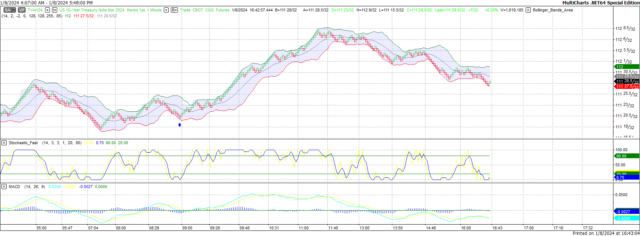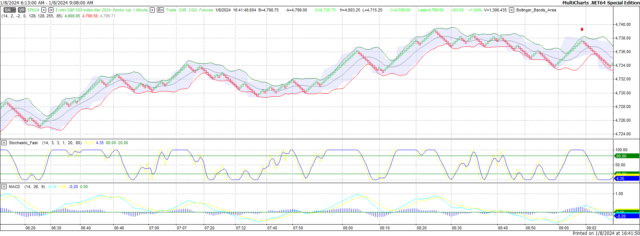USD: Mar '24 is Up at 102.190.
Energies: Feb '24 Crude is Up at 72.17.
Financials: The Mar '24 30 Year T-Bond is Down 19 ticks and trading at 121.30.
Indices: The Dec '23 S&P 500 emini ES contract is 88 ticks Lower and trading at 4781.75.
Gold: The Feb'24 Gold contract is trading Up at 2040.00.
Initial conclusion
This is not a correlated market. The USD is Up and Crude is Up which is not normal, but the 30 Year T-Bond is trading Lower. The Financials should always correlate with the US dollar such that if the dollar is Higher, then the bonds should follow and vice-versa. The S&P is Lower and Crude is trading Higher which is correlated. Gold is trading Higher which is not correlated with the US dollar trading Up. I tend to believe that Gold has an inverse relationship with the US Dollar as when the US Dollar is down, Gold tends to rise in value and vice-versa. Think of it as a seesaw, when one is up the other should be down. I point this out to you to make you aware that when we don't have a correlated market, it means something is wrong. As traders you need to be aware of this and proceed with your eyes wide open. Asia is trading mainly Higher with the exception of the Hang Seng which is Lower. Currently all of Europe is trading Lower.
Possible challenges to traders
-
NFIB Small Business Index is out at 6 AM EST. This is Major.
-
Trade Balance is out at 8:30 AM EST. This is Major.
-
RCM/TIPP Economic Optimism - Tentative. This is Major.
-
FOMC Member Barr Speaks at 12 noon EST. This is Major.
Treasuries
Traders, please note that we've changed the Bond instrument from the 30 year (ZB) to the 10 year (ZN). They work exactly the same.
We've elected to switch gears a bit and show correlation between the 10-year bond (ZN) and the S&P futures contract. The S&P contract is the Standard and Poor's, and the purpose is to show reverse correlation between the two instruments. Remember it's likened to a seesaw, when up goes up the other should go down and vice versa.
Yesterday the ZN migrated Higher at around 9 AM EST as the S&P hit a High at around the same time. If you look at the charts below the S&P gave a signal at around 9 AM and the ZN started its Upward trend. Look at the charts below and you'll see a pattern for both assets. S&P hit a High at around 9 AM and migrated Lower. These charts represent the newest version of MultiCharts and I've changed the timeframe to a 15-minute chart to display better. This represented a Long opportunity on the 10-year note, as a trader you could have netted about a 20 plus ticks per contract on this trade. Each tick is worth $15.625. Please note: the front month for the ZN is now Mar '24. The S&P contract is now Mar' 24. I've changed the format to filled Candlesticks (not hollow) such that it may be more apparent and visible.
Charts courtesy of MultiCharts built on an AMP platform
ZN - Mar 2024 - 01/08/24
S&P - Mar 2024 - 01/08/24
Bias
Yesterday we gave the markets a Neutral bias as we didn't see much in the way of correlation Monday morning. The markets migrated Higher as the Dow gained 217 points and the other indices gained ground as well. Today we aren't dealing with a correlated market and our bias is to the Downside.
Could this change? Of Course. Remember anything can happen in a volatile market.
Commentary
Yesterday it was difficult to tell what the market direction would be and as such gave the markets a Neutral bias which means it could go anywhere. But what surprised us was there wasn't any real, major economic news on tap yesterday, yet the indices soared. All three major indices leaped to the Upside. I get the old saying is correct, sometime no news is good news. Today we have Trade Balance and an FOMC member speaking. Will this be enough to keep the momentum moving forward? As in all things, only time will tell.
Trading performance displayed herein is hypothetical. The following Commodity Futures Trading Commission (CFTC) disclaimer should be noted.
Hypothetical performance results have many inherent limitations, some of which are described below. No representation is being made that any account will or is likely to achieve profits or losses similar to those shown.
In fact, there are frequently sharp differences between hypothetical performance results and the actual results subsequently achieved by any particular trading program. One of the limitations of hypothetical performance trading results is that they are generally prepared with the benefit of hindsight.
In addition, hypothetical trading does not involve financial risk, and no hypothetical trading record can completely account for the impact of financial risk in actual trading. For example, the ability to withstand losses or to adhere to a particular trading program in spite of trading losses are material points which can also adversely affect actual trading results.
There are numerous other factors related to the markets in general or to the implementation of any specific trading program which cannot be fully accounted for in the preparation of hypothetical performance results and all of which can adversely affect actual trading results.
Trading in the commodities markets involves substantial risk and YOU CAN LOSE A LOT OF MONEY, and thus is not appropriate for everyone. You should carefully consider your financial condition before trading in these markets, and only risk capital should be used.
In addition, these markets are often liquid, making it difficult to execute orders at desired prices. Also, during periods of extreme volatility, trading in these markets may be halted due to so-called “circuit breakers” put in place by the CME to alleviate such volatility. In the event of a trading halt, it may be difficult or impossible to exit a losing position.
Recommended Content
Editors’ Picks

Gold price jumps to refresh record high above $3,070 amid Trump's tariff plans
Gold price hits a fresh all-time peak above $3,070 in the Asian session on Friday as escalating global trade tensions, the uncertainty over Trump's reciprocal tariffs, and the risk-off mood continue to drive safe-haven flows. Bets that the Fed will resume its rate-cutting cycle soon lend additional support to the bullion.

USD/JPY falls toward 150.50 after hot Tokyo CPI; US PCE awaited
USD/JPY has come under moderate selling pressure and heads toward 150.50 early Friday. Hot Tokyo CPI figures and BoJ's March Summary of Opinions ramp up BoJ rate hike bets, supporting the Japanese Yen. Meanwhile, tariff jitters undermine the US Dollat, bolstering the haven demand for the Yen.

AUD/USD drops below 0.6300 amid trade war fears
AUD/USD drops back below 0.6300 in Friday's Asian trading, undermined by broad risk-aversion due to US President Trump's latest auto tariffs announcements. Traders now look to the US PCE Price Index for some meaningful impetus. Hopes for more stimulus from China could cap the Aussie's decline.

XRP yet to see gains despite Ripple's partnership with Chipper Cash
XRP failed to recover on Thursday, noting a 2% decline despite Ripple's latest partnership with mobile payment services provider Chipper Cash. The collaboration aims to support cross-border payments for Chipper Cash using Ripple Payments.

US: Trump's 'Liberation day' – What to expect?
Trump has so far enacted tariff changes that have lifted the trade-weighted average tariff rate on all US imports by around 5.5-6.0%-points. While re-rerouting of trade will decrease the effectiveness of tariffs over time, the current level is already close to the highest since the second world war.

The Best brokers to trade EUR/USD
SPONSORED Discover the top brokers for trading EUR/USD in 2025. Our list features brokers with competitive spreads, fast execution, and powerful platforms. Whether you're a beginner or an expert, find the right partner to navigate the dynamic Forex market.

